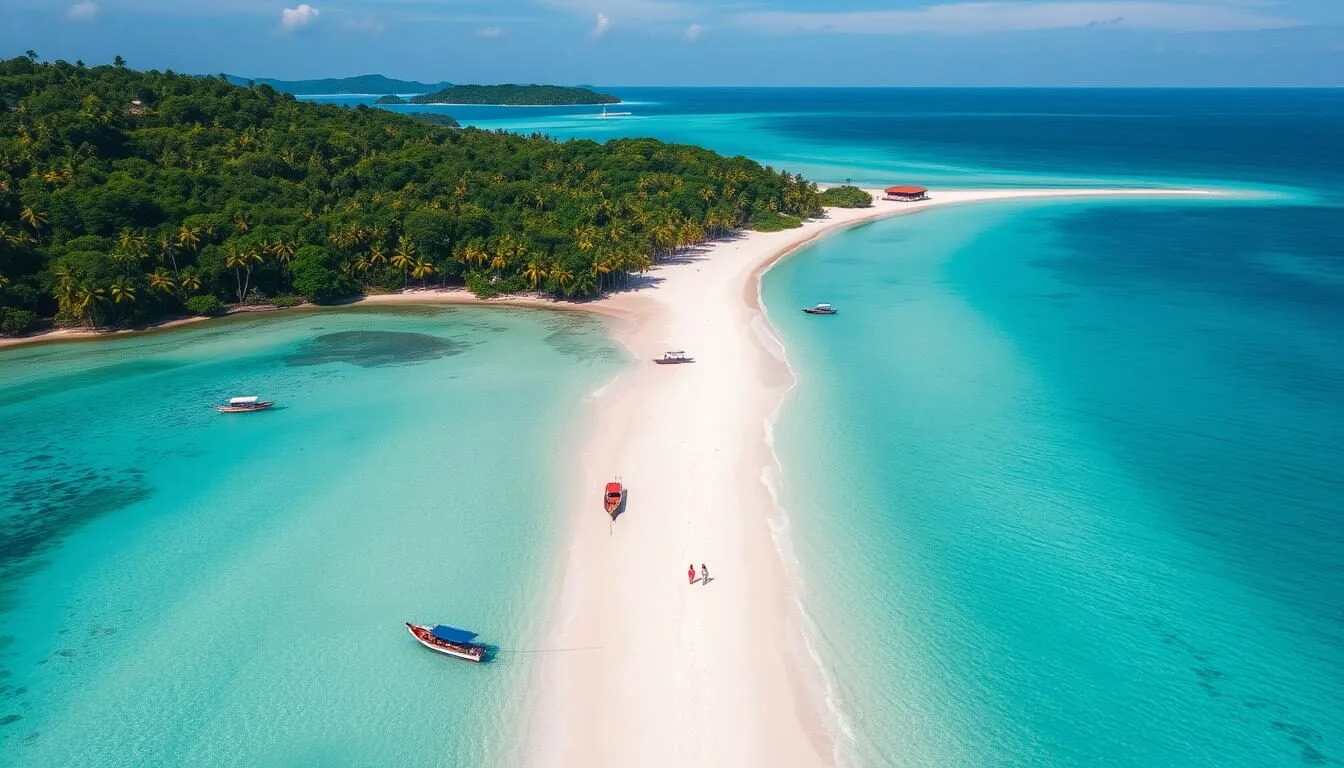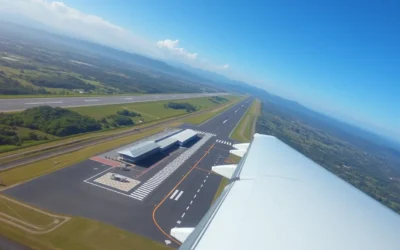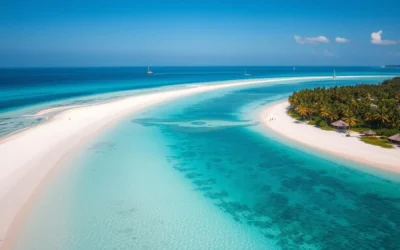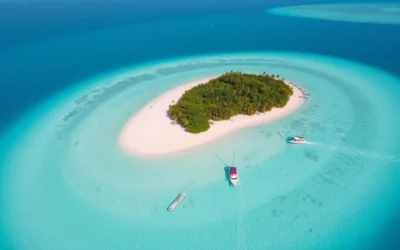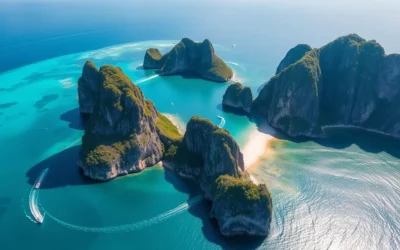✓ Accommodations✓ Flights✓ Rental Cars✓ Tours & Activities
Did you know that Panglao Island hosts over 400 species of coral and 2,500+ species of marine life in its UNESCO-recognized biodiversity hotspot? This tropical paradise in the Philippines packs more underwater diversity per square mile than almost anywhere else on the planet. Connected to Bohol by two bridges, this small island has rapidly transformed from a hidden gem to one of the Philippines’ most sought-after destinations – without losing its authentic charm.
Whether you’re seeking pristine beaches, world-class diving, island-hopping adventures, or simply a slice of tropical bliss, Panglao delivers experiences that rival destinations twice its size. Let’s explore the very best this island paradise has to offer, with insider tips to make your visit truly unforgettable.
Getting to Panglao Island
Reaching this slice of paradise is easier than ever thanks to the new Bohol-Panglao International Airport that opened in 2018. This modern facility welcomes flights from major Philippine cities and some international destinations, making Panglao more accessible than ever before.
By Air
The most convenient way to reach Panglao is flying directly to Bohol-Panglao International Airport. Several airlines operate daily flights from Manila and Cebu, with the journey taking approximately 1-1.5 hours from Manila or just 30 minutes from Cebu.
Ready to book your flight to paradise? Check available flights and secure the best rates today!
By Sea
If you’re already in Cebu, taking a ferry to Bohol is an affordable alternative. Fast ferries operate between Cebu City and Tagbilaran (Bohol’s capital) multiple times daily, with the journey taking approximately 2 hours. From Tagbilaran, Panglao Island is just a 30-minute drive across the connecting bridges.
Several ferry companies serve this route, including OceanJet and FastCat, with tickets ranging from PHP 500-800 ($9-15 USD) for standard class. It’s advisable to book your tickets in advance during peak season.

Best Time to Visit Panglao Island
Panglao Island enjoys a tropical climate with distinct dry and wet seasons. Understanding these patterns will help you plan the perfect trip based on your preferences for activities, budget, and crowd levels.
Dry Season (November-May)
The most popular time to visit Panglao is during the dry season, particularly from December to February when temperatures hover around 28-30°C (82-86°F). This period offers ideal conditions for beach activities, diving, and island hopping with minimal rain interruption.
Keep in mind that December through February represents peak tourist season, with higher accommodation rates and more crowded attractions. March to May brings hotter temperatures (up to 34°C/93°F) but fewer tourists.
Wet Season (June-October)
The wet season brings occasional rain showers, higher humidity, and slightly lower temperatures around 26-29°C (79-84°F). Despite the name, rain typically comes in short bursts rather than all-day downpours, with plenty of sunshine between showers.
This period offers significant advantages: lower prices (up to 40% less on accommodations), fewer tourists, and lush green landscapes. Many experienced travelers consider this the secret best time to visit.
Shoulder Seasons
For the perfect balance of good weather and smaller crowds, consider visiting during the shoulder months of November or May. These transitional periods often feature favorable weather conditions with fewer tourists and more reasonable prices.
November marks the beginning of the dry season with landscapes still lush from recent rains, while May offers hot but less crowded conditions before the rainy season begins in earnest.
Traveler’s Tip: If diving is your priority, visit between March and June when visibility is at its best (often exceeding 30 meters). Whale shark sightings are most common from November to May.
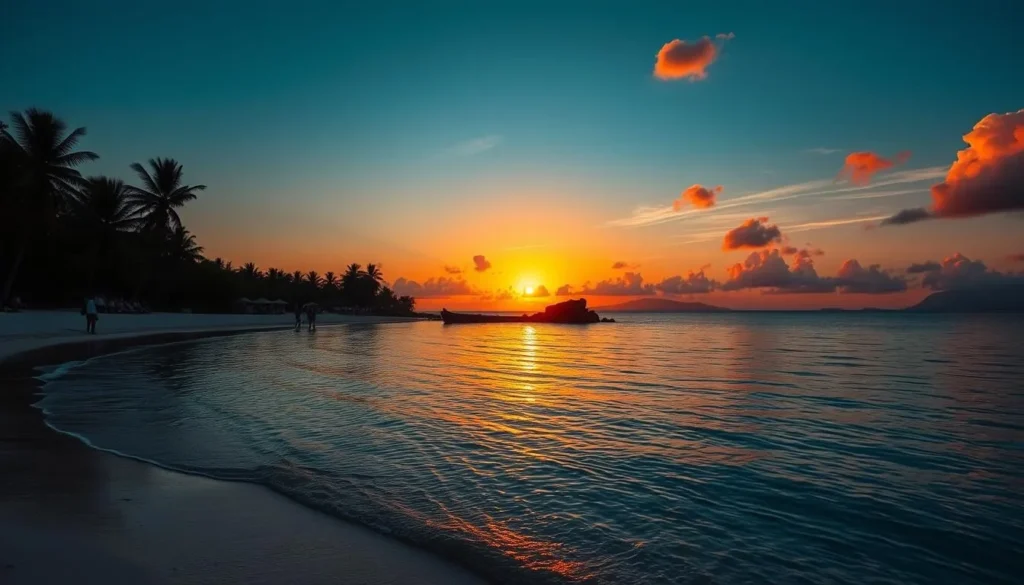
Getting Around Panglao Island
Panglao Island is relatively small (approximately 91 square kilometers), making it easy to explore. The island offers several transportation options to suit different preferences and budgets.
Motorbike Rental
Renting a motorbike or scooter is the most popular and flexible way to explore Panglao. Rentals typically cost between PHP 350-500 ($6-9 USD) per day, with discounts available for longer rentals. Most accommodations can arrange this for you, or you’ll find rental shops in tourist areas like Alona Beach.
An international driver’s license is technically required, though enforcement is inconsistent. Always wear a helmet and drive cautiously, as road conditions can vary.
Tricycles
These modified motorcycles with sidecars are Panglao’s equivalent to taxis. They’re readily available in populated areas and provide an authentic local experience. Short trips within the same area cost around PHP 20-50 ($0.40-1 USD) per person, while longer journeys across the island might cost PHP 150-300 ($3-6 USD).
Always agree on the price before starting your journey, as tricycles don’t use meters.
Car Rental
For families or groups, renting a car provides comfort and convenience. Daily rates start from PHP 2,000-3,500 ($35-65 USD) depending on the vehicle type. Most rentals come with a driver, which is recommended given the sometimes challenging road conditions and local driving practices.
Explore Panglao Island at your own pace with a reliable rental car. Compare options and book in advance for the best rates.
Habal-Habal (Motorcycle Taxi)
These motorcycle taxis are a quick and affordable option for solo travelers. Simply flag one down on the street or ask your accommodation to call one for you. Prices are similar to tricycles but can be negotiated, especially for longer journeys.

Where to Stay in Panglao Island
Panglao offers accommodations for every budget and preference, from luxury beachfront resorts to charming budget guesthouses. The island has several distinct areas, each with its own character and advantages.
Alona Beach Area
The most developed and popular area on Panglao, Alona Beach offers a 1.5km stretch of white sand lined with restaurants, bars, dive shops, and accommodations. This is the heart of Panglao’s tourist scene.
Best for: First-time visitors, nightlife enthusiasts, and those who want everything within walking distance.
Price range: Budget hostels from $10-20/night; mid-range hotels $40-80/night; luxury resorts $150+/night.
Dumaluan Beach Area
Located about 15 minutes from Alona, Dumaluan Beach offers a quieter atmosphere with wider beaches and less development. The sand here is often considered superior to Alona’s, and the swimming conditions are excellent.
Best for: Families, couples seeking more tranquility, and beach lovers.
Price range: Mid-range resorts $50-100/night; luxury beachfront properties $120-250+/night.
Panglao Town & Inland Areas
Staying in Panglao Town or other inland areas offers a more authentic local experience and generally lower prices. While not beachfront, most locations are still just a short ride from the coast.
Best for: Budget travelers, long-term stays, and those seeking a local experience.
Price range: Budget guesthouses $15-30/night; mid-range options $35-60/night.
Find Your Perfect Stay in Panglao
From beachfront luxury resorts to charming budget guesthouses, find the perfect accommodation for your Panglao Island adventure.
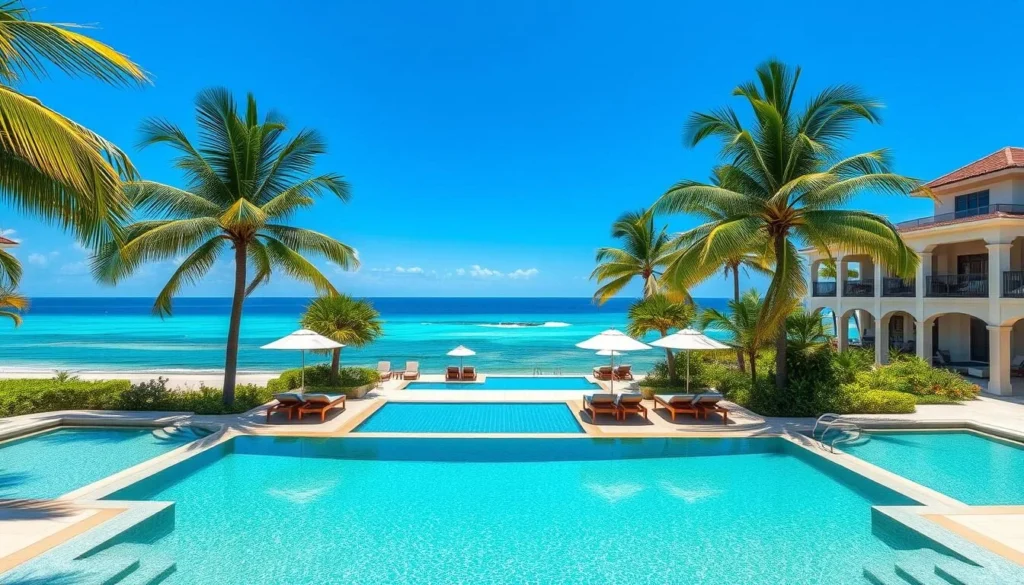
Top Attractions in Panglao Island
Panglao Island packs an impressive array of attractions into its modest size. From pristine beaches to natural wonders, here are the must-visit spots that should be on every traveler’s itinerary.
Alona Beach
Panglao’s most famous beach features a 1.5km stretch of white sand lined with restaurants, bars, and dive shops. While busier than other beaches on the island, it offers excellent infrastructure and a lively atmosphere, especially at sunset when the beachfront comes alive.
The northern end tends to be quieter, while the central area hosts most of the restaurants and activities. Despite its popularity, the water remains clear and ideal for swimming.
Dumaluan Beach
Often considered to have the finest sand on Panglao, Dumaluan Beach offers a quieter alternative to Alona. The beach features a wide shoreline with powdery white sand and excellent swimming conditions. Several resorts have sections of the beach, but public access is available for a small fee (around PHP 25/$0.50 USD).
The shallow, clear waters make this beach particularly family-friendly, and there are fewer boats moored offshore compared to Alona.
Hinagdanan Cave
This naturally lit limestone cave features a crystal-clear underground lagoon that’s perfect for a refreshing dip. Sunlight filters through small openings in the ceiling, creating a magical atmosphere as it illuminates the impressive stalactite and stalagmite formations.
The cave is easily accessible via a concrete stairway and requires about 30-45 minutes to explore. Entrance fee is PHP 50 ($1 USD) with an additional PHP 25 if you wish to swim.
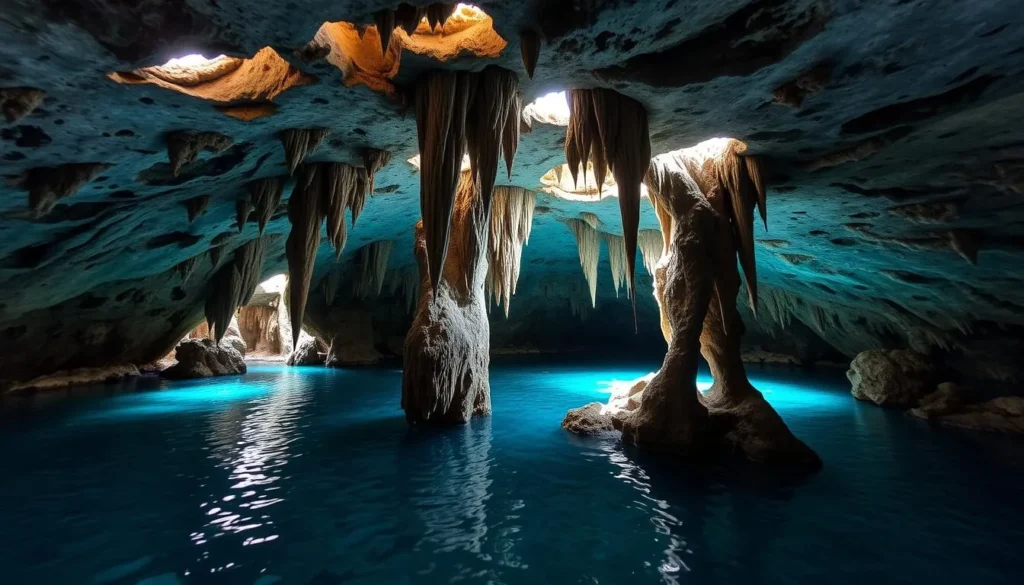
Panglao Church (St. Augustine Church)
Dating back to 1851, this historic church showcases Spanish colonial architecture with its distinctive white façade and bell tower. The interior features beautiful ceiling paintings and religious artifacts. Located in Panglao town, the church remains an active place of worship and offers a glimpse into the island’s cultural heritage.
Bohol Bee Farm
More than just an apiary, this organic farm and resort offers fascinating tours of its sustainable farming practices, beekeeping operations, and handicraft production. The on-site restaurant serves delicious organic meals featuring farm-fresh ingredients, and their homemade ice cream (especially the malunggay and spiced honey flavors) has achieved legendary status among visitors.
Don’t miss the chance to shop for organic products and handcrafted souvenirs at their store.
Doljo Beach
Located on the northwestern coast of Panglao, Doljo Beach offers a more secluded experience with fewer tourists. The long stretch of white sand provides excellent sunset views and a glimpse into local fishing life. While facilities are limited compared to Alona, this adds to its authentic charm.
The beach is ideal for those seeking tranquility and a more genuine connection with local island life.
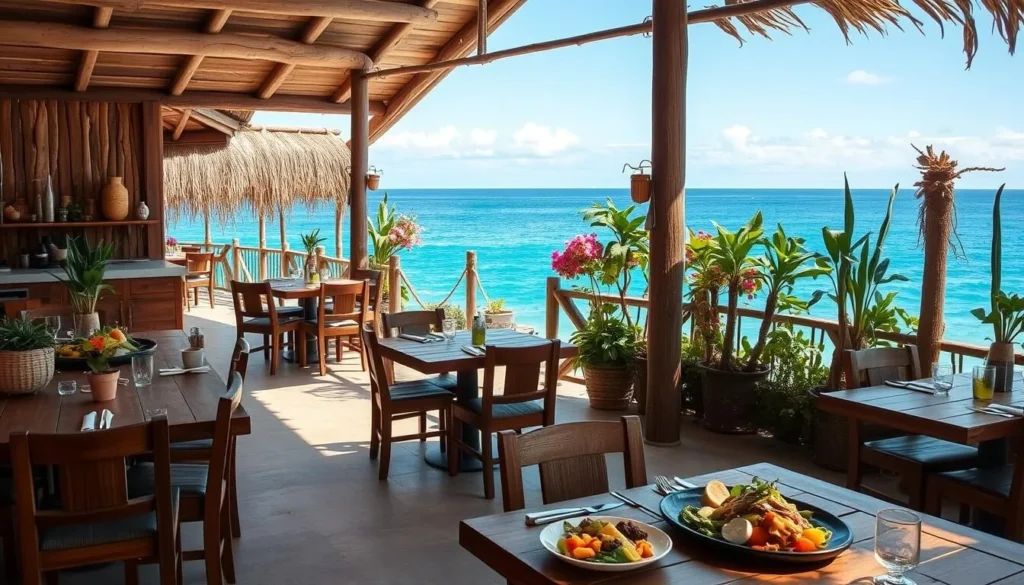
Island Hopping Adventures from Panglao
Some of Panglao’s greatest treasures lie just offshore. Island hopping tours offer access to pristine marine sanctuaries and secluded sandbars that showcase the Philippines’ world-renowned natural beauty.
Balicasag Island
Just 45 minutes by boat from Panglao, Balicasag Island is a marine sanctuary renowned for its spectacular diving and snorkeling opportunities. The island is surrounded by a coral reef teeming with marine life, including sea turtles, colorful fish, and vibrant coral gardens.
The most famous spot is the “Black Forest” – an area with dense black coral formations. Snorkelers can enjoy the “Turtle Point” where sea turtles are frequently spotted feeding on seagrass. The island itself features a small local community, white sand beaches, and basic facilities for day visitors.
Experience the underwater wonders of Balicasag Island with a guided snorkeling tour. Includes boat transportation, snorkeling gear, and lunch.
Book Island Hopping Tour
Virgin Island (Pungtud Island)
This small uninhabited island features a stunning sandbar that emerges during low tide, creating a long, narrow stretch of pristine white sand surrounded by crystal-clear turquoise waters. The sandbar’s shape changes slightly with the seasons and tides, but it consistently offers one of the most photogenic landscapes in the region.
There are no permanent structures on the island, though local vendors sometimes set up small stalls selling fresh seafood, coconuts, and souvenirs during peak hours. The shallow waters surrounding the sandbar are perfect for wading and photography.
For the best experience, visit early in the morning before the crowds arrive or check the tide schedule to ensure the sandbar is fully visible during your visit.
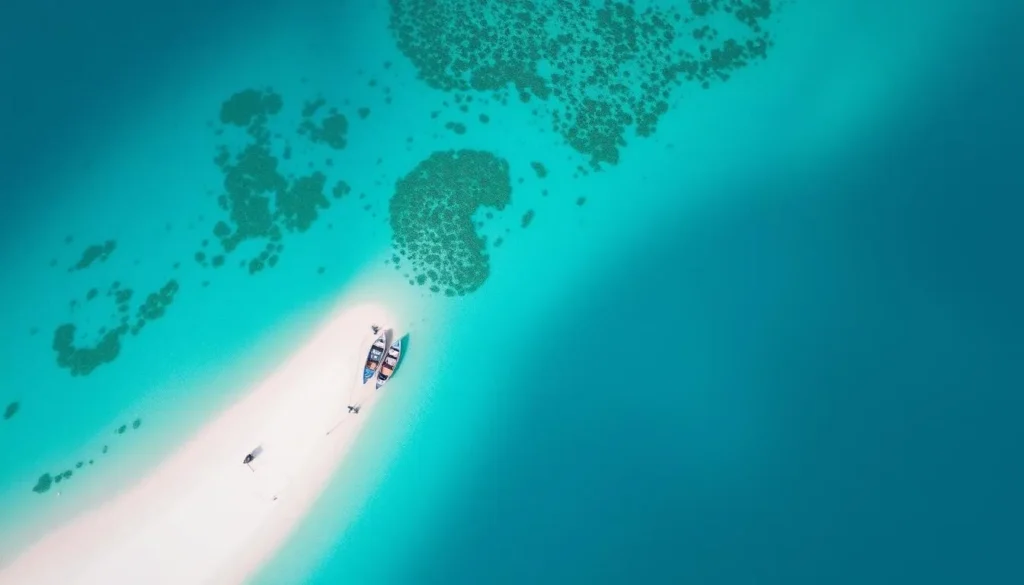
Pamilacan Island
Located about 12.5 km from Panglao, Pamilacan Island was traditionally a whaling community but has transformed into a center for sustainable dolphin and whale watching. The waters around the island are frequented by spinner dolphins, bottlenose dolphins, and even whale sharks (between March and June).
Beyond marine life viewing, the island offers excellent snorkeling opportunities, a small white sand beach, and a 200-year-old Spanish fort. The local community offers homestay options for those wishing to experience authentic island life beyond a day trip.
Island Hopping Tips
- Most tours depart between 6:00-7:00 AM to avoid crowds and take advantage of calmer morning waters
- Standard island hopping tours include Balicasag Island and Virgin Island, while Pamilacan requires a separate trip
- Bring cash for entrance fees, environmental fees (PHP 50-300 depending on the islands visited), and optional purchases
- Pack reef-safe sunscreen, a hat, water, and snacks
- Consider booking a private boat (PHP 2,000-3,500) for a more flexible experience
- The best visibility for snorkeling is typically from March to June
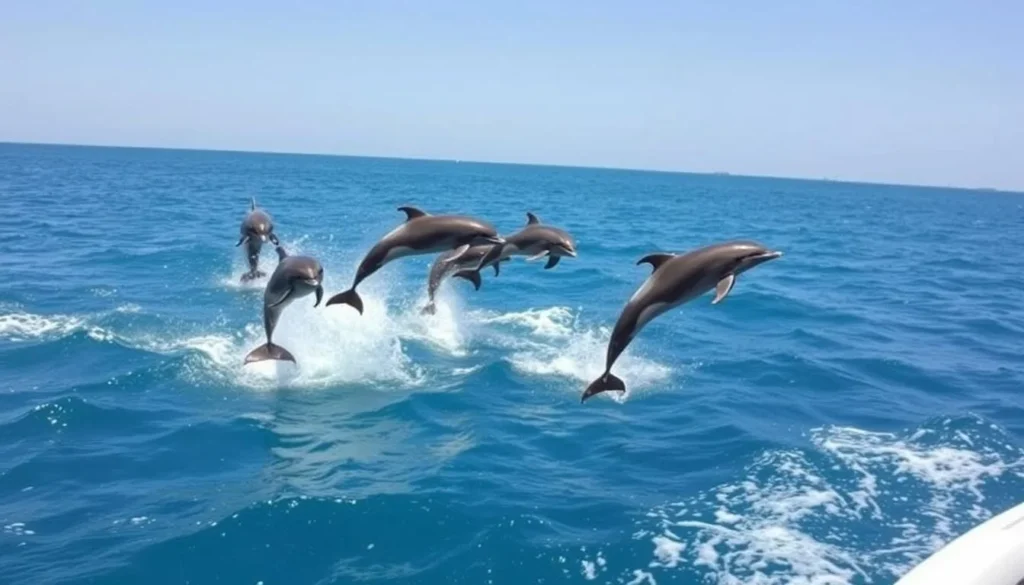
Diving and Snorkeling in Panglao
Panglao Island is a world-class diving destination with over 30 dive sites catering to all experience levels. The surrounding waters host an incredible diversity of marine life, from tiny nudibranchs to majestic sea turtles and occasional whale sharks.
Top Dive Sites
- Balicasag Marine Sanctuary: Famous for its turtle population, stunning wall dive, and vibrant “Black Forest” coral area
- Arco Point: Features a natural underwater arch and rich macro life
- Doljo Point: Known for rare critters and excellent muck diving
- Napaling: Offers dramatic wall dives with the chance to see barracudas and jacks
- Puntod: A sloping reef with abundant soft corals and reef fish
Dive Centers
Panglao hosts numerous PADI and SSI-certified dive centers, primarily concentrated around Alona Beach. Reputable operations include:
- Bohol Divers Club
- Sea Explorers
- Philippine Fun Divers
- Alona Divers
- GoScuba
Prices typically range from PHP 1,500-2,500 ($27-45 USD) for a single dive with equipment, with discounts for multiple dives or package deals.
Snorkeling Spots
Not a certified diver? Panglao offers excellent snorkeling opportunities:
- Balicasag Island: The shallow “Turtle Point” area is perfect for snorkelers
- Alona Beach Reef: Accessible from shore at the eastern end
- Doljo Beach: Offers good snorkeling during high tide
- Dumaluan Beach: Features patches of coral accessible from shore
Snorkeling gear rental costs around PHP 150-300 ($3-6 USD) per day from beachfront vendors.
Discover Panglao’s Underwater Wonders
Experience world-class diving with certified instructors. Suitable for beginners and experienced divers alike.
Book a Diving Experience
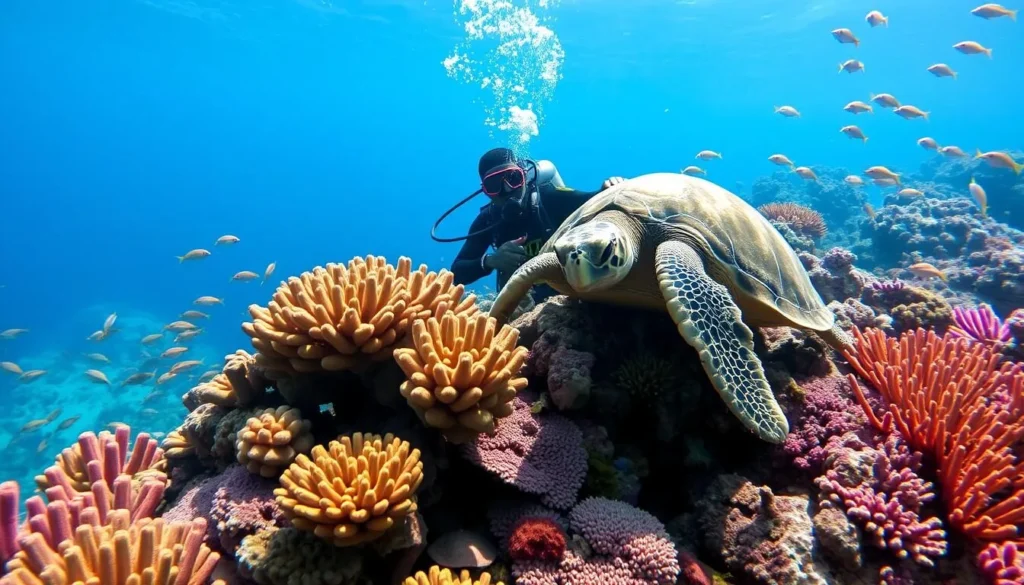
Day Trips from Panglao Island
While Panglao itself offers plenty to explore, its strategic location makes it the perfect base for discovering the larger island of Bohol and its famous attractions. These day trips provide a wonderful contrast to Panglao’s beach-focused experiences.
Chocolate Hills
Bohol’s most iconic attraction features over 1,200 perfectly cone-shaped hills spread across an area of more than 50 square kilometers. These geological formations turn chocolate-brown during the dry season (hence the name) but remain an impressive sight year-round.
The main viewing points are in Carmen (about 1.5 hours from Panglao) and Sagbayan Peak, which offers additional attractions like a butterfly sanctuary and children’s park. The best times to visit are early morning or late afternoon when temperatures are cooler and the lighting is ideal for photography.
Philippine Tarsier Sanctuary
Located in Corella (approximately 45 minutes from Panglao), this conservation area provides a natural habitat for the Philippine tarsier – one of the world’s smallest primates. These nocturnal creatures, with their enormous eyes and tiny bodies (about the size of a human fist), are endangered and incredibly sensitive to noise and stress.
The sanctuary offers responsible viewing opportunities with knowledgeable guides who help spot the well-camouflaged animals in their natural environment. Visit in the afternoon when they’re more likely to be awake.
Loboc River Cruise
This relaxing experience takes you down the emerald-green Loboc River on a floating restaurant while enjoying Filipino cuisine and cultural performances. The 1-hour cruise passes by lush jungle scenery, small waterfalls, and traditional riverside communities.
Most cruises include a buffet lunch or dinner and a stop at a performance area where local children perform traditional Filipino dances. The standard rate is around PHP 550 ($10 USD) per person including the meal.
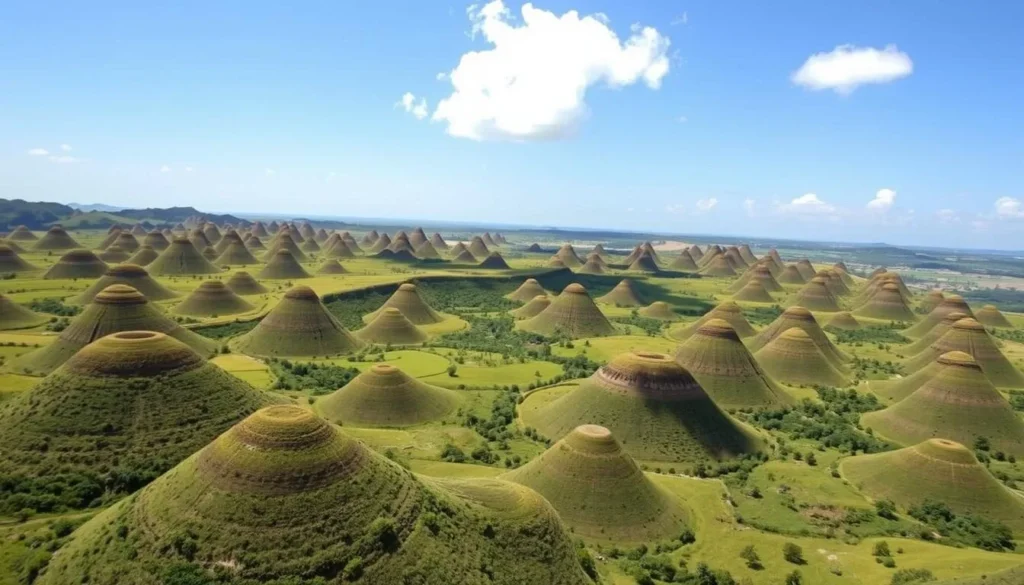
Explore Bohol’s Natural Wonders
Experience the best of Bohol with a full-day countryside tour including the Chocolate Hills, tarsier sanctuary, and Loboc River cruise.
Book Countryside Tour
Man-Made Forest
The Bilar Man-Made Forest is a 2-kilometer stretch of densely planted mahogany trees creating a cathedral-like tunnel effect along the highway between Loboc and the Chocolate Hills. The dramatic change in vegetation from the surrounding areas makes for a striking visual experience and excellent photo opportunities.
This reforestation project dates back to the 1960s and provides a cool, shaded respite during hot days. Most countryside tours include a brief stop here.
Baclayon Church
One of the oldest stone churches in the Philippines, Baclayon Church (officially the Church of Our Lady of the Immaculate Conception) was originally built in 1727. Though damaged in the 2013 earthquake, the restored structure remains an important historical landmark.
The adjacent museum houses religious artifacts, ancient scripts, and relics from the Spanish colonial period. Located just 6 kilometers from Tagbilaran City, it’s an easy addition to any Bohol itinerary.
Mag-Aso Falls
For travelers seeking off-the-beaten-path experiences, these twin waterfalls in Antequera (about 40 minutes from Tagbilaran) offer a refreshing natural swimming spot surrounded by lush forest. The name “Mag-Aso” means “smoky” in the local dialect, referring to the mist created by the cascading water.
Facilities are basic but include changing rooms and picnic areas. The site involves a descent down approximately 197 concrete steps, so moderate fitness is required.

Activities and Experiences in Panglao
Beyond beaches and diving, Panglao offers a diverse range of activities to enhance your island experience. From adrenaline-pumping adventures to cultural immersions, there’s something for every type of traveler.
Sunset Watching
Panglao’s western beaches offer spectacular sunset views that transform the sky into a canvas of orange, pink, and purple hues. Prime locations include:
- Alona Beach – enjoy from one of the many beachfront bars
- Doljo Beach – more secluded with fewer crowds
- Momo Beach – quiet and perfect for photography
For an elevated experience, several resorts and restaurants offer sunset cocktails with panoramic views of the changing colors reflecting on the Bohol Sea.
Firefly Watching
Experience the magical sight of thousands of fireflies illuminating the mangroves along the Abatan River (on Bohol’s mainland, about 30 minutes from Panglao). Evening tours take you by boat through the river where these bioluminescent insects create a natural light show.
Tours typically last 1-2 hours and cost around PHP 800-1,200 ($15-22 USD) per person. The best viewing conditions occur on darker nights away from the full moon.
Cliff Jumping
Thrill-seekers can head to Molave Cliff Diving Resort (also known as Alexis Cliff Dive Resort) on Panglao’s southern coast. This popular spot offers platforms at various heights (3-15 meters) for cliff jumping into crystal-clear waters.
The resort charges a small entrance fee (PHP 100/$2 USD) and provides basic facilities including restrooms and seating areas. The site also offers good snorkeling opportunities around the base of the cliffs.
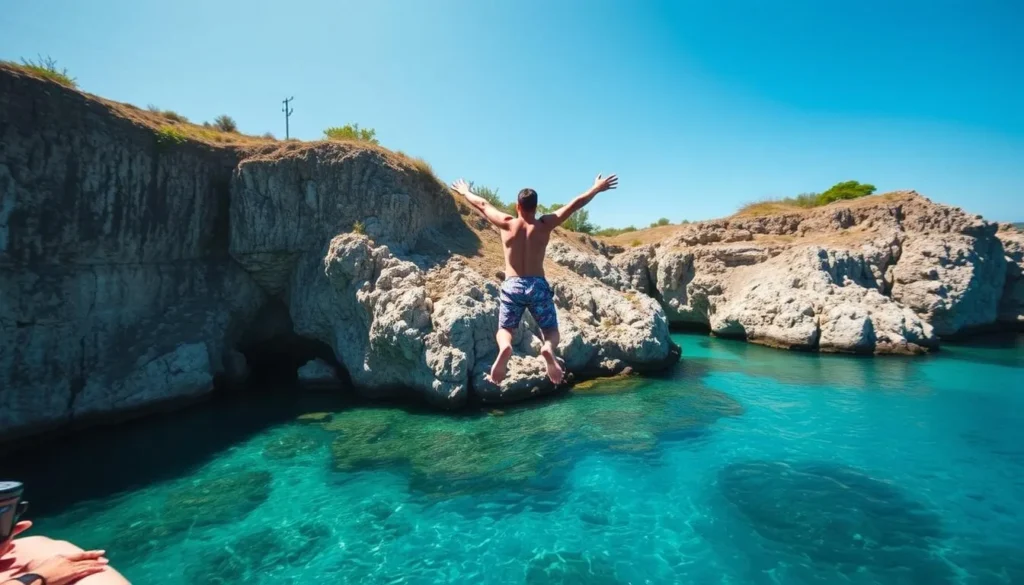
Paddleboarding & Kayaking
Explore Panglao’s coastline at a leisurely pace by renting a paddleboard or kayak. These activities are particularly enjoyable during calm mornings when the water is mirror-like. Several beaches offer rentals, with rates typically around PHP 300-500 ($5-9 USD) per hour.
Dumaluan Beach and the quieter sections of Alona Beach are ideal launching points, allowing you to paddle along the coast and discover small coves and marine life from above.
Cooking Classes
Learn to prepare traditional Filipino dishes through interactive cooking classes offered by several restaurants and resorts. These hands-on experiences typically include a market visit to source fresh ingredients, followed by preparation of 3-4 dishes such as adobo, sinigang, and local Bohol specialties.
Classes last 3-4 hours and cost around PHP 1,500-2,500 ($27-45 USD) per person, including the meal you prepare. Bohol Bee Farm and some resorts in Alona offer regular classes.
Beach Cleanup Initiatives
Give back to the island by participating in community beach cleanup events. Organizations like Plastic Free Bohol regularly organize cleanup activities that welcome tourist participation. These events provide an opportunity to connect with locals and other travelers while contributing to environmental conservation.
Check with your accommodation or local dive shops for upcoming cleanup schedules, or visit the Plastic Free Bohol social media pages for announcements.

Dining and Culinary Experiences in Panglao
Panglao’s dining scene offers everything from local Filipino favorites to international cuisine, with an emphasis on fresh seafood and tropical ingredients. Here’s where to find the best culinary experiences on the island.
Local Delicacies
Don’t leave Panglao without trying these regional specialties:
- Kinilaw – Filipino ceviche made with fresh fish marinated in vinegar and citrus
- Humba – Bohol’s version of pork adobo, slightly sweeter with black beans
- Calamay – sticky sweet delicacy made from glutinous rice, coconut milk, and brown sugar
- Sikwate – traditional hot chocolate made from local cacao
- Ube Kinampay – purple yam desserts made from Bohol’s famous variety
Beachfront Dining
Alona Beach offers numerous restaurants with tables directly on the sand, creating a magical dining atmosphere, especially at sunset. Prices at beachfront establishments are higher than inland options but still reasonable by international standards.
Most beachfront restaurants feature fresh seafood displays where you can select your fish, prawns, or lobster to be prepared according to your preference. Expect to pay PHP 250-600 ($4.50-11 USD) for main dishes.
Bohol Bee Farm Restaurant
This organic farm-to-table restaurant offers a unique dining experience featuring ingredients grown on-site. The open-air setting provides beautiful ocean views, while the menu showcases creative dishes incorporating honey and organic vegetables.
Don’t miss their signature salad with edible flowers, squash bread with honey butter, and homemade ice cream in unusual flavors like malunggay (moringa), spiced honey, and ube. Reservations are recommended for dinner.
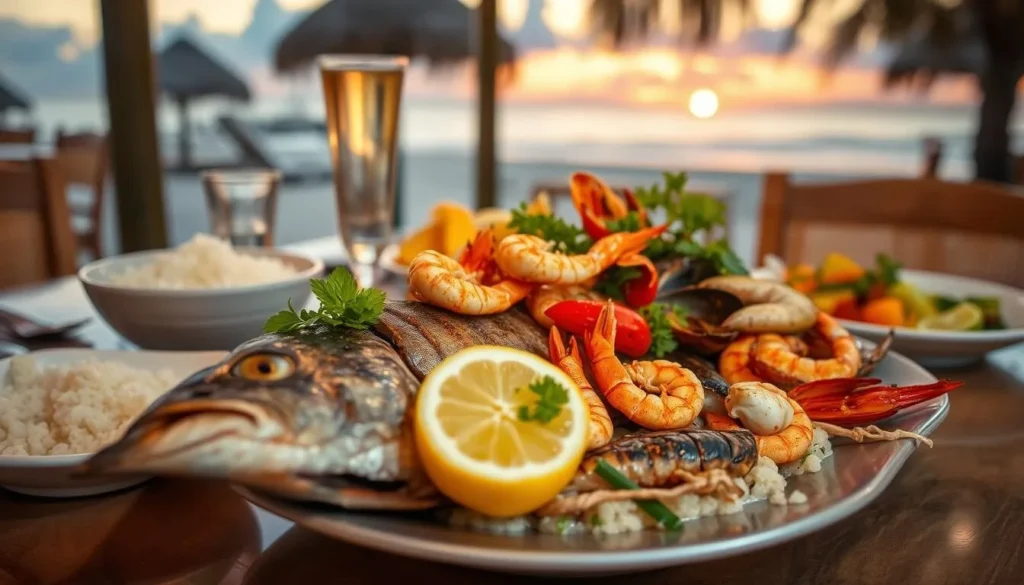
Local Markets
For an authentic culinary experience, visit Panglao Public Market in the morning to see locals trading fresh produce, seafood, and spices. Some vendors offer ready-to-eat local snacks and breakfast items that provide an affordable taste of everyday Filipino cuisine.
The larger Tagbilaran City Public Market (on Bohol’s main island) offers an even more extensive selection and makes for an interesting half-day excursion.
Budget-Friendly Options
While tourist areas feature higher-priced restaurants, budget travelers can find delicious, affordable meals at:
- Carinderia – local eateries serving home-style Filipino food for PHP 80-150 ($1.50-3 USD) per meal
- Gerarda’s – popular restaurant in Tagbilaran serving Filipino classics at reasonable prices
- Alona night food stalls – set up in the evenings with barbecue and simple dishes
- Tarsier Botanika – surprisingly affordable given the beautiful setting and quality
Dining Tips
- Seafood is generally priced by weight (per 100g), so confirm the cost before ordering
- Many restaurants add a 10% service charge automatically
- Reservations are recommended for popular restaurants, especially during high season
- For the freshest seafood, dine at places where you can select your items from a display
- Most restaurants close relatively early (around 9-10 PM)
- Bring cash, as many smaller establishments don’t accept cards
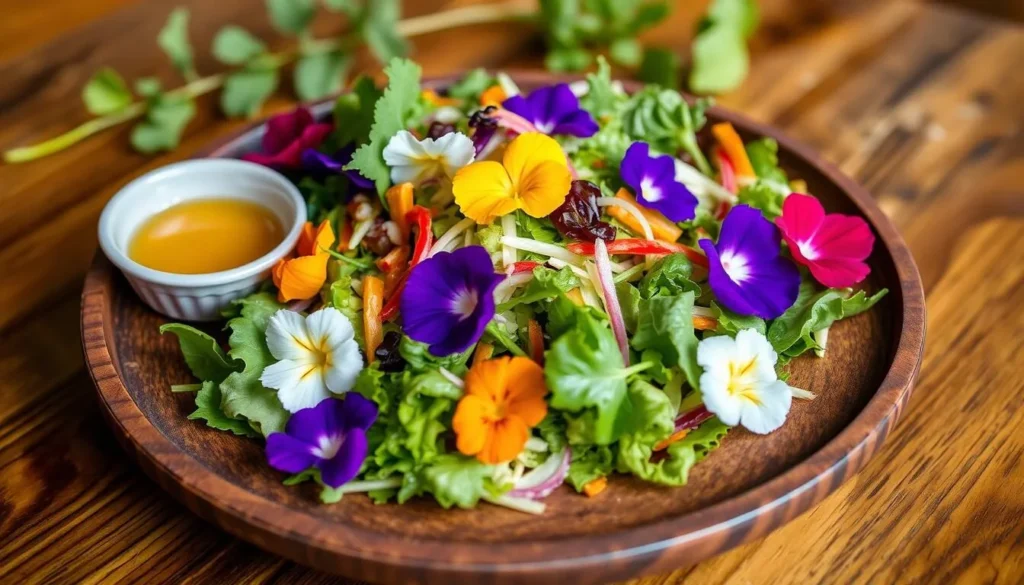
Practical Tips for Visiting Panglao Island
Make the most of your Panglao adventure with these essential tips covering everything from money matters to local etiquette and safety considerations.
Money Matters
- The local currency is the Philippine Peso (PHP)
- ATMs are available in Alona Beach and Panglao town, but may charge high fees
- Withdraw sufficient cash in Tagbilaran City where more banks are available
- Major resorts and restaurants accept credit cards, but smaller establishments are cash-only
- Bring small denominations for tricycles, market purchases, and entrance fees
- Tipping is not mandatory but appreciated (10% is standard for good service)
Connectivity
- Mobile coverage is generally good in populated areas
- Major providers include Globe and Smart – purchase a local SIM card at the airport or in Tagbilaran
- Most accommodations offer free Wi-Fi, though speed and reliability vary
- Download offline maps before exploring remote areas
- Power outages occasionally occur – keep devices charged and bring a power bank
Health & Safety
- Panglao is generally safe for tourists
- Use standard travel precautions regarding valuables
- Bring reef-safe sunscreen, insect repellent, and a basic first-aid kit
- Drink bottled or purified water only
- Medical facilities on Panglao are limited – serious issues require transport to Tagbilaran or Cebu
- Comprehensive travel insurance is strongly recommended
Environmental Responsibility: Panglao’s delicate marine ecosystems face increasing pressure from tourism. Do your part by avoiding single-use plastics, using reef-safe sunscreen, never touching coral or marine life, and participating in beach cleanup initiatives when possible.
Local Etiquette
- Filipinos are generally friendly and accommodating – a smile goes a long way
- Dress modestly when visiting churches or local communities (cover shoulders and knees)
- Remove shoes when entering someone’s home if you see shoes at the entrance
- Using basic Filipino phrases like “Salamat” (thank you) is appreciated
- Ask permission before photographing locals, especially children
- Respect marine sanctuaries and protected areas by following all guidelines
Packing Essentials
- Lightweight, breathable clothing
- Swimwear and beach cover-ups
- Reef-safe sunscreen and insect repellent
- Snorkeling gear (though rentals are available)
- Waterproof phone case or dry bag
- Light rain jacket during wet season
- Comfortable walking shoes and flip-flops
- Reusable water bottle and shopping bag
Budgeting
Daily budget estimates (per person):
- Budget: PHP 1,500-3,000 ($27-55 USD) – hostels, local eateries, public transport, select activities
- Mid-range: PHP 3,000-6,000 ($55-110 USD) – mid-range hotels, restaurant meals, regular activities
- Luxury: PHP 6,000+ ($110+ USD) – resort stays, fine dining, private tours
Save money by traveling during shoulder season, eating at local establishments, and negotiating tour prices directly with operators.
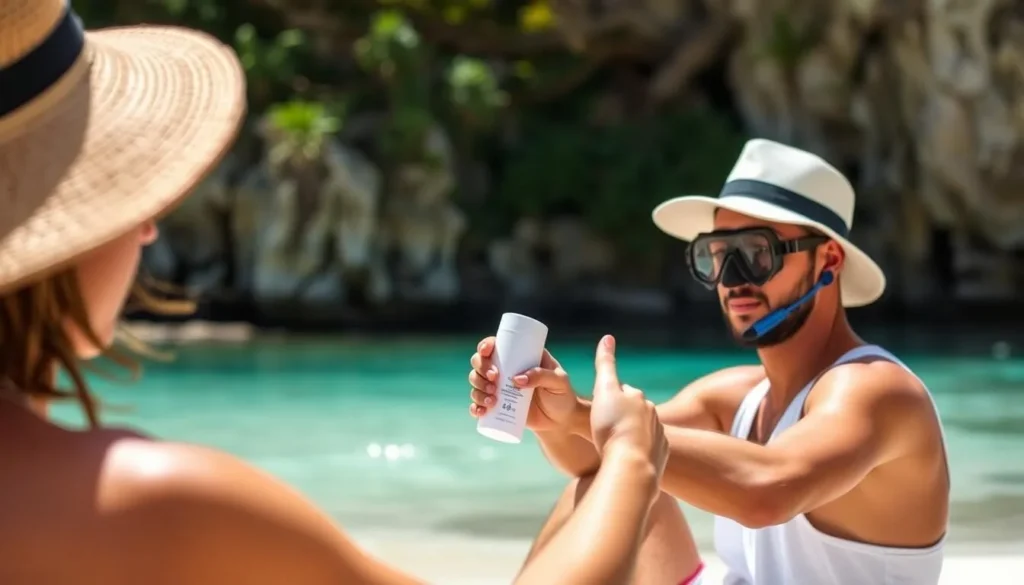
Ready for Your Panglao Island Adventure?
Panglao Island may be small in size, but it delivers experiences that rival destinations many times larger. From the moment your feet touch its powdery white sand, you’ll understand why travelers from around the world are drawn to this Philippine paradise. Whether you’re diving among vibrant coral gardens, island-hopping to secluded sandbars, or simply soaking in a technicolor sunset with a fresh coconut in hand, Panglao offers memories that linger long after your tan fades.
What makes Panglao truly special is its perfect balance – developed enough to offer comfort and convenience, yet still authentic enough to provide genuine cultural experiences and natural beauty. As you plan your journey to this tropical haven, remember that the island operates on “island time” – so slow down, embrace the laid-back pace, and allow yourself to be fully present in paradise.
Start Planning Your Panglao Island Getaway
From flights and accommodations to unforgettable experiences, we’ve got everything you need for the perfect Panglao adventure.

—
The above is subject to change.
Check back often to TRAVEL.COM for the latest travel tips and deals.
